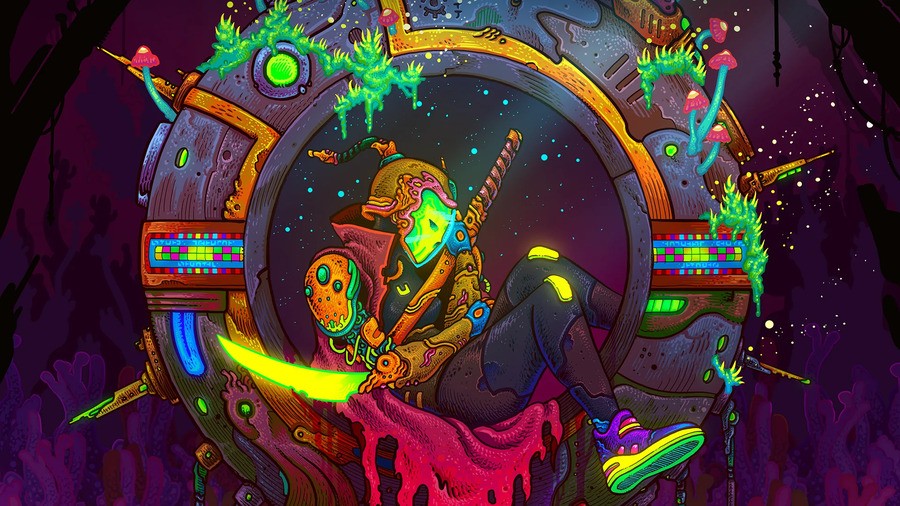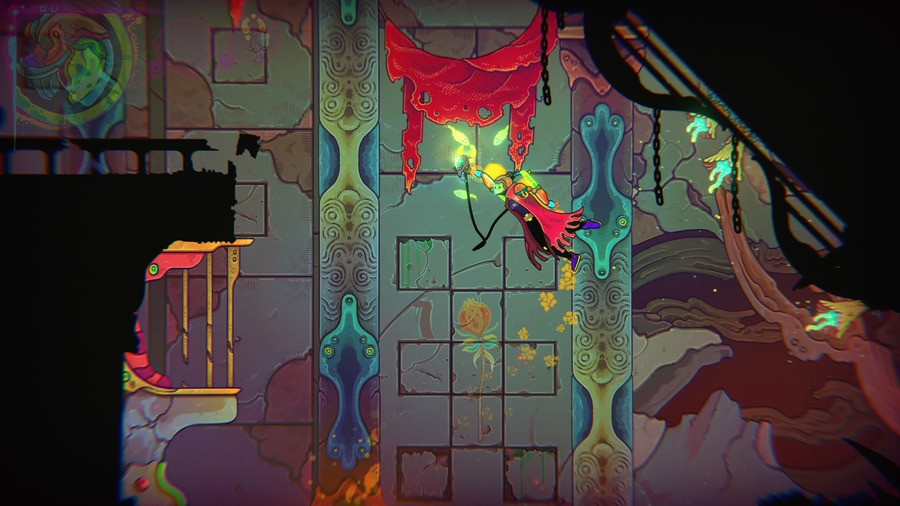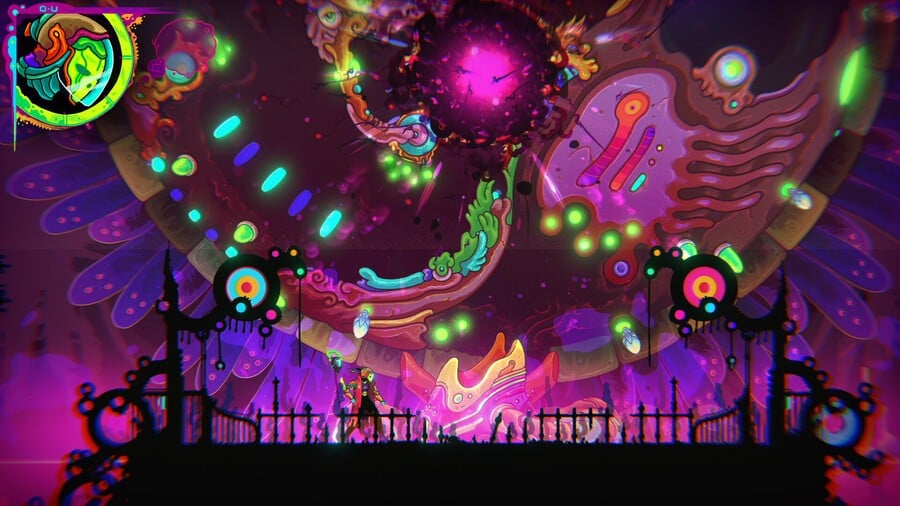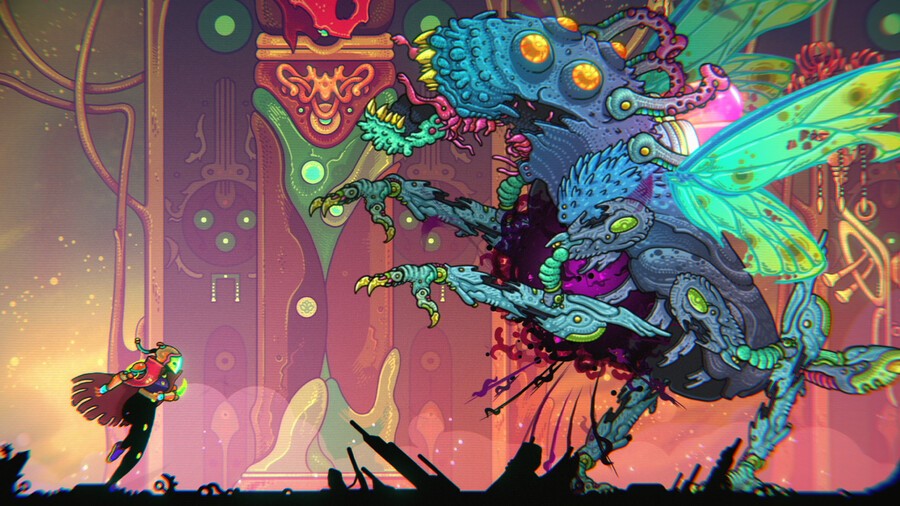
Not only is February a big month for the AAA titles of the world, but it's also lined up some fascinating indie games for PS5, PS4 owners to digest. Alongside Pacific Drive is Ultros, an incredibly colourful platformer promising just as much brutal action as there is calming gardening. It is out for Sony's two systems on 13th February 2024, and to learn more ahead of release, we caught up with game design director Mårten Brüggemann to ask maybe one too many questions.
For those who missed its announcement, could you share a brief introduction to Ultros?
Mårten Brüggemann: Ultros is a psychedelic sci-fi platform adventure where players explore lush, richly detailed landscapes aboard the strange and cosmic world of The Sarcophagus. Ultros features daring blade-based combat that rewards expertise and finesse, exotic flora players can cultivate and grow, plus mind-bending time loops that have players revisit familiar – yet strangely different – locales. Ultros explores spiritual and philosophical themes regarding karmic cycles and our relation to nature and hopes to expand the hearts and minds of players who explore its depths and uncover its darkest mysteries within.
Could you explain how the loop-based nature of the gameplay works? Are we looking at a rogue-like experience just as much as a Metroidvania? How will the environment change as you progress through these loops?
While we don't consider Ultros to be a roguelike, we still had to take the notion into consideration that using semantics like “loops” and “cycles” would lead to comparisons with roguelikes. So, I see it more as if the game flirts and plays with the use of roguelike mechanics without them being the core of the experience.
Instead, it focuses on the exciting parts of retreading familiar ground but with new knowledge and priming of situations in previous cycles. The loop gives the player chances to explore “what if I do this instead” scenarios. It directly ties into the game’s philosophies of a karmic cycle, and lets the player explore this through their own agency. It means you will relive certain things and scenarios but get to see them from different perspectives. But as with a karmic cycle, the secret of it lies in what survives the loop. Some aspects of the world live on through the loop and allow you to evolve the world over loops.
Real gardening work is also based around cycles, or seasons, what you plant at one point can either grow larger or die during the course of a season. I’m also very fond of stories based around closed timeloop concepts, such as the movies Groundhog Day and Primer. There’s usually a stage of acceptance and overcoming the hurdle of living in a timeloop instead using it to achieve a larger goal, which are values we’ve tried to weave into the game design of Ultros' loop structure.

What sort of abilities can we look forward to unlocking, and how long will it take for us to get the double jump?
I’m happy to announce that double jumping is one of the first abilities you will unlock!
There are two main systems for unlocking new abilities, the Extractor and the Cortex. The Extractor is a small hovering pod that is connected to the player. It is a multiuse tool that can be upgraded with different functions that let you interact with and explore the world. Its upgrades will let you trim thorny bushes and dig tunnels in the ground, for example.
The Cortex, on the other hand, is the game’s skill tree that will let you unlock memories of the player character. These memories are often, but not always, connected to the player’s fighting moves. There are a few different fight mechanics in the game which you can choose to use more or less of. You can also upgrade the ones you feel are most suited to your way of playing. The different fight mechanics include counter moves that let you react to your enemies’ attacks, juggling attacks that let you hit enemies into each other, and a variety of airborne, heavy, and sliding attacks that you can unlock.
You can combine the attacks however you like, and you’re seldom required to use specific attacks in any situation. But the main combo reward system at play promotes variety in attacks. Described in-game as inflicting blunt force trauma to your victims, using the same attack over and over will make the spoils you get from defeating a foe become “battered,” i.e. less valuable.
How do you go about striking the right balance between the game’s violent combat and the more relaxing gardening mechanics where you grow plants?
The two mechanics have some overlapping factors; they are both part of the same ecosystem. This is something you will explore and understand more as you progress in the game. But a simple example is that you get nutrition from both fruit that you grow and spoils from fighting, and nutrition is what you use for unlocking new abilities in the game. Your first relation to the plants will be to grow more nutritious fruits to expand your arsenal of combat moves, so there’s a synergy there.
The further you journey into the Sarcophagus you will also find that the gardening mechanics aren’t solely for leisure, but a key aspect of progressing in the game and intertwined in the fate or the game world. So, both mechanics, combat and gardening, become vital aspects of the exploration of the world. There is soil all over to plant in, gardening is always present. We also added a lot of active elements to gardening, juggling seeds, trimming branches, etc., so there’s not necessarily as big of a tempo shift between the two paradigms as you’d imagine. We internally called it “action gardening.”
Can you only grow plants in specific areas, sort of like a save room in Resident Evil, or can they be planted anywhere?
There are many places to plant your seeds from the get-go, but you also get many tools to expand your gardens beyond just the initial dirt patches. And by getting to know how each plant works and what kind of special abilities they have, you can shape how you get around in the game world. The gardening system is pretty dynamic, and we look forward to seeing what players will create with it!

Are there any other Metroidvanias you’ve taken inspiration from when developing Ultros? The recent Prince of Persia: The Lost Crown created some neat accessibility options to help with remembering where you could use new abilities — do you hope to have something similar in Ultros either at launch or via a patch after release?
Castlevania: Symphony of the Night has definitely been an inspiration for Ultros. The thing I love about it is that it has all these quirks left in, for example, secret movements or just small details that can be missed. But when you do find them, it gives so much personality to the game. It has a rare openness to how you can approach it that is rarely seen in the genre. That aspect is something we have strived for in Ultros as well.
Ultros does not have a way to add notes on the map, as Prince of Persia: The Lost Crown featured. It is a pretty nifty feature though and has almost become a convention in the genre in some form or another. However, ULTROS’ secrets and progression locks are less about finding an ability at point A and using it at point B, and more about continuously expanding where you can go by getting to know the gardening aspects of the world. But for some players and completionists, it could still be a feature that would be useful to have, too.
Could you speak to the game’s impressive, colourful art style? Where did you draw inspiration from and how did you come up with such a unique look?
If you are familiar with the art of our art director, Niklas ‘El Huervo’ Åkerblad, you will recognize the maximalist use of color and the visual overload of the pictures. A lot of his personal inspiration comes from comics and concept artists such as Moebius and Stan Sakai. For Ultros, inspiration came from the almost reverent depiction of nature from Studio Ghibli, and Nausicaä in particular. The sort of organic take on sci-fi was moulded after Moebius and H.R. Giger’s works in the genre.

As the developer’s first game together, how did it feel to have Ultros announced on such a big stage as a PlayStation Showcase?
Overwhelming! Announcing your game, especially after working on it for so many years, is always daunting. But showing off the game at the Showcase and at various events this past year has been a really positive experience. It’s given perspective and a very welcome boost of energy in the final push of the development, knowing that someone is actually excited about your game!
Why do you believe Push Square readers need to keep their eye on Ultros as it nears release?
We hope you will enjoy our take on the Metroidvania genre! We’re a pretty small team and everyone put their hearts and souls into the game, making it quite a personal game for all of us. There are many stories and experiences from our own lives that have inspired the themes of the game. There are also many things to explore in the game world and we hope to surprise you with its many twists and turns. We’ve tried our best to find interesting ways to break conventions in the genre and games as a whole, while still honouring the legacy of the games we ourselves grew up with and loved. All in all, if you are interested in something very unique yet strangely familiar, we hope you will give Ultros! a shot!
We would like to thank Mårten Brüggemann for taking the time to answer our questions, and Colby Tortorici for making the interview possible. Are you looking forward to playing Ultros on PS5, PS4 13th February 2024? Get your own garden growing in the comments below.





Comments 12
Wow, this game looks cool. Nice interview!
Very awesome. It was not on my radar before, but I am going to have to reconsider now that I see some of the influences. I just worried it was another metroidvania (I've got more than enough to play in that genre at the moment) with rogue like elements.
Ooooow, seafood soup! I had no clue this game came out so soon. Love the unique art style and it's definitely been on my radar since it was revealed. Added to my wishlist!
Already preordered a PS5 physical copy of this game.
Thanks Liam, this was great. I had totally forgotten about it but definitely excited to pick it up 👍
The characters' run animation looks pretty blocky in the trailer though. Its jarring
I’m really seriously weighing my options between this and like half a dozen games before FF7. I really like some of the ideas in this one a lot after reading the interview. Really appreciated reading this!
I like the idea of metroidvania with roguelike elements as opposed to full on roguelike
I really like the look of this. Looks like the devs took some LSD when making it. Only thing is, it's 30 quid physical and I've already got a coupla three metroidvanias on the go.
This is the kind of article I love on this site! (Not the clickbait, just sayin’)
Thats a great interview and a fantastic article Liam. Thank you.
This game sounds like one I want to play. How I'm gonna find time is beyond me!
Art is very unique and cool, I'm going to play this.
Tap here to load 12 comments
Leave A Comment
Hold on there, you need to login to post a comment...